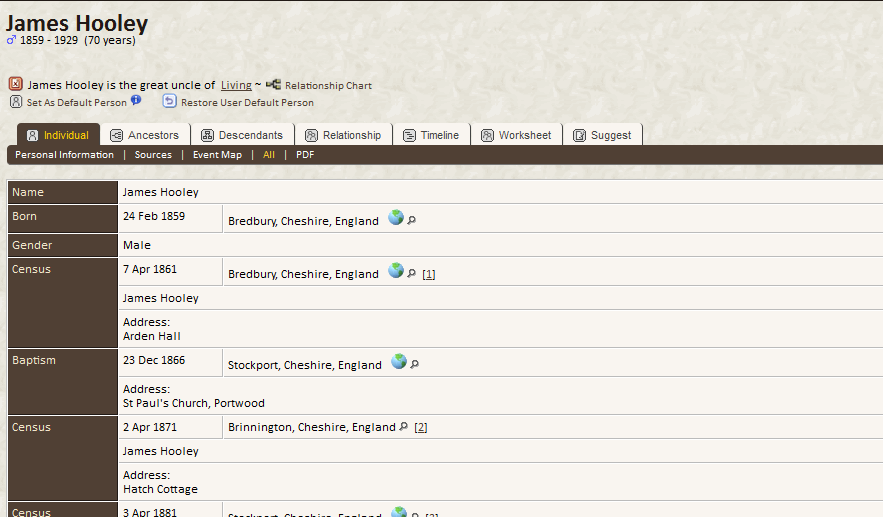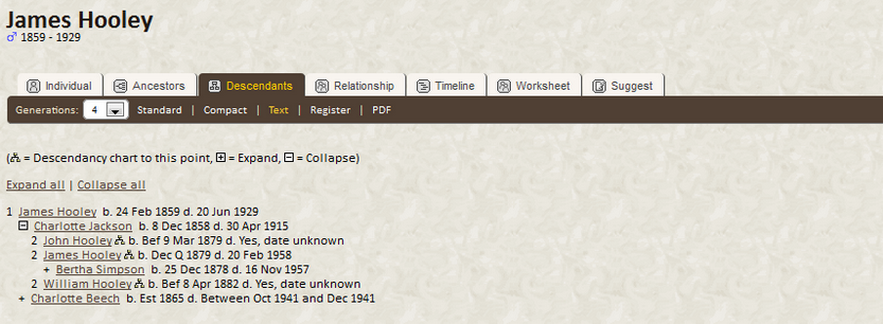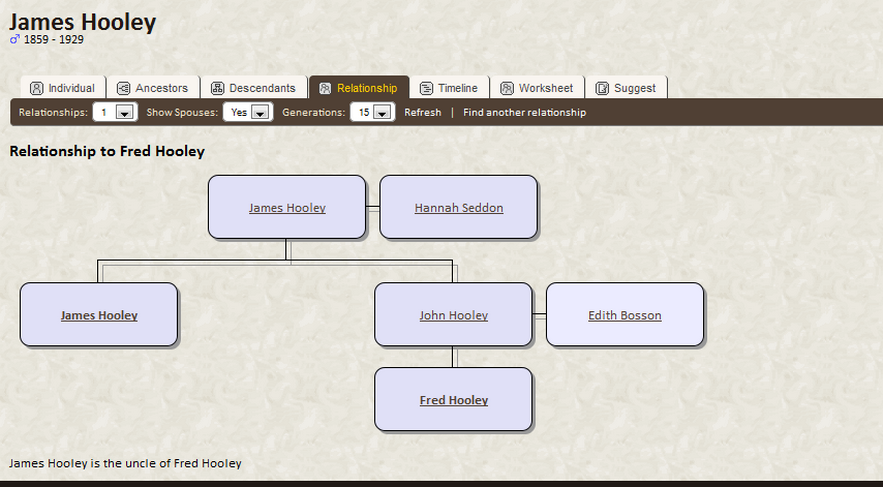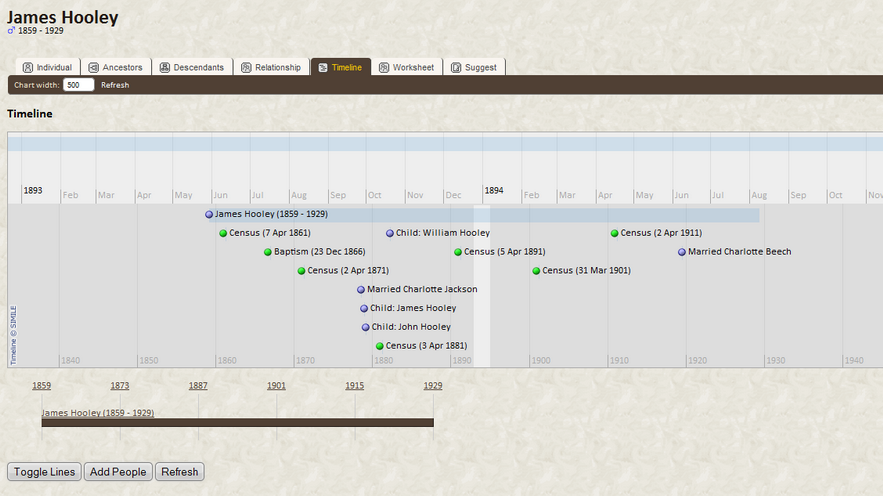Frequently Asked Questions
Some of these questions and other topics will be covered in more detail on the Help page.
Q: How do I find who I am looking for?
A: There are a number of ways, but the 'Search' function provides the most straight forward method. The search box on the bottom right of the Home page provides a simple 'Last Name' and 'First Name' search. There is also a link for "Advanced Search" and one to "Search Families". Advanced search (also as 'Search' at the top left of all other pages) allows you to enter various information about the individual you're looking for. The Family search offers the best way to search for a woman if you do not know her maiden (unmarried) name. All methods present you with a list of possible matches from the database.
There are some other Name types in 'Other Search Criteria' on the Advanced Search page: for example the person you are looking for may have changed their name or have been known by an alternative name.
You might also want to try looking at 'Surnames' or 'First Names' if you don't have a clear picture of who you're looking for. You'll find these in the Home page menu and the 'Find' drop-down menu at the top right of all pages. If you think the person is likely to be there but you can't find them, then please contact us for help.
Q: How do I find an individual's ancestors?
A: Once you locate an individual and have displayed the person's details, the easiest method is to press the Ancestors tab.
A: The tab marked Descendants can be used to display the descendants of an individual. There are four different formats in which descendants can be displayed. You can switch between these to display the information the way that works best for you.
A: Yes, You can click on the "Standard" view and see all of the descendants (with photos), or you can go to the "Text" view and view a specific branch of descendants (with photos) from the selected ancestor by clicking on the descendant icon next to the descendant you wish to display. This chart view includes the siblings of each ancestor. Thus, the younger the individual, the greater the number of generations in the chart; and the greater the number of siblings in a family, the wider the chart becomes.
next to the descendant you wish to display. This chart view includes the siblings of each ancestor. Thus, the younger the individual, the greater the number of generations in the chart; and the greater the number of siblings in a family, the wider the chart becomes.
Q: Is there a way to tell if two individuals are related?
A: Yes, the Relationship tab will show a graphic display of all the people between two relatives. To use this function, locate the first individual and then press the Relationship tab. Then use the find button to locate the second person to be displayed. Once you have the two people selected click the calculate button to display their relationship.
Q: What is the Timeline function?
A: A timeline is displayed for an individual when the Timeline tab is clicked. The time line shows important events in history that occurred during the life of an individual or a group of individuals. It gives you a unique perspective to see what was going on in the world during the lives of our ancestors.
A: The suggestion tab allows you to send corrections, updates, comments or any other information to the database administrator. Information on which individual you are referencing is automatically attached to the message when you make a suggestion using the Suggestion tab. The database administrator will evaluate your suggestion and add it to the database in the next web update cycle if appropriate.
Q: Is there a way to print the display without all the headers and icons?
A: Yes, just click on the Print link locate above the control tabs. A format that is simplified for printing is presented and you can use the print function of your browser to print the page.
NOTE: On the Individual, Ancestors and Descendants pages you have the option to create a report in 'pdf' format for the information you are viewing. To make use of this option you will need to have installed Adobe Reader in order to view the report. If you don't already have it, you can download the (free) Adobe Reader software by clicking this link.
Q: What are the drop-down boxes for on the upper right of the page?
A: These provide menus that let you quickly access any area of the site to see additional information contained in the database. The area is divided into four menus Find, Media, Info and Other. You can hover your mouse pointer over each to see the options available. Click on the one you want.
Note: Some options are only available to registered users.
Q: Why can't I see all the information on a certain person?
A: I take care to protect the privacy of all family members. All names, dates and other information of living individuals are 'hidden'. Registered users can have access to this information. If you are a direct descendant or relative of people listed on this website, please take a moment to register by clicking on "Register for a User Account" on the home page. You will be asked to provide evidence of your relationship. When accepted, you will be able to view the records of living ancestor's and descendant's contained in the database.
Q: What are the benefits of Registering as a User?
A: To see the details of living ancestor's and descendant's and their records, documents, photographs and biographies etc, you must Register for a User account, and Log In when registration is approved. Registration also ensures that I can e-mail you with any major changes to the site.
Q: What if I forget my username and/or password?
A: If you can't remember your username then, via the 'Log In' page, enter the email address you supplied when you registered and I will send you your username.
However, for security purposes I do not have access to your password. So, if you forget it, you can ask the system, again via the 'Log In' page, to issue you with a temporary one. Just enter the email address you supplied when you registered and your username.
Q: How do I use the Google Map displayed on the Individual Page?
A:
A: It's not always possible to identify a woman's maiden, or birth surname. There could be a number of reasons for this but the most common are multiple marriages (surname at the time of the marriage is not the maiden name) or the marriage took place before Civil Registration (Sept 1837) and/or Parish Records are not available or it could just mean that research on this person is yet to be completed. Rather than simply entering "Unknown" for the surname, I have chosen to enter the woman's married surname inside brackets. This will at least identify her as married and help when searching for her. It should be noted that this use of brackets comes from my own implementation in my offline genealogy software, it is not a standard method of displaying a married woman's surname.
A:The dictionary is quite clear on it's definition of a cousin.
All clear so far? Good. Now lets look at the definition of second cousins. The dictionary defines second cousins as....
Ready for the next step? Third cousins are defined by the dictionary as....
So, now you have that bit but what does once or twice removed mean? The number of times removed by, is defined by the difference between the number of generations to the common ancestor. This is how the Encyclopedia of Genealogy describes it:
Here's how to calculate the relationship.
The closest common ancestor is the Grandparent of the Subject (two generations) who is also the great-grandparent of the Cousin's Child (three generations).
When the number of generations to the common ancestor is not the same for both the subject and the relative, the first part of the relationship term is determined by the lesser of the two distances to the common ancestor. In this case, that is two, and so the first part of the relationship is "First Cousin". The second part of the relationship term is determined by the difference between the two distances to the common ancestor. In this case, that is one (three minus two), and so the relationship term is First Cousin, Once Removed.
After reading the above, one might be tempted to call a niece or nephew a "sibling once removed", but I don't recommend it!
Please note that a descendant of your first cousin can never be a second cousin to you. The number of times removed increases with each generation. As shown below, a second cousin is related through one of your great grandparents.
The relationship from a child of your great aunt or great uncle to you is the same as the relationship from you to a child of your 1st cousin.
You can use the chart below to calculate the relationship between two people.
Count the generations between the common ancestor and person 1. Use that number to find the proper column. Then count the generations between the common ancestor and person 2. Use that number to find the proper row.
The relationship is shown at the intersection of the column and row.

Q: How do I find who I am looking for?
A: There are a number of ways, but the 'Search' function provides the most straight forward method. The search box on the bottom right of the Home page provides a simple 'Last Name' and 'First Name' search. There is also a link for "Advanced Search" and one to "Search Families". Advanced search (also as 'Search' at the top left of all other pages) allows you to enter various information about the individual you're looking for. The Family search offers the best way to search for a woman if you do not know her maiden (unmarried) name. All methods present you with a list of possible matches from the database.
There are some other Name types in 'Other Search Criteria' on the Advanced Search page: for example the person you are looking for may have changed their name or have been known by an alternative name.
You might also want to try looking at 'Surnames' or 'First Names' if you don't have a clear picture of who you're looking for. You'll find these in the Home page menu and the 'Find' drop-down menu at the top right of all pages. If you think the person is likely to be there but you can't find them, then please contact us for help.
Q: How do I find an individual's ancestors?
A: Once you locate an individual and have displayed the person's details, the easiest method is to press the Ancestors tab.


A: The tab marked Descendants can be used to display the descendants of an individual. There are four different formats in which descendants can be displayed. You can switch between these to display the information the way that works best for you.

A: Yes, You can click on the "Standard" view and see all of the descendants (with photos), or you can go to the "Text" view and view a specific branch of descendants (with photos) from the selected ancestor by clicking on the descendant icon
Q: Is there a way to tell if two individuals are related?
A: Yes, the Relationship tab will show a graphic display of all the people between two relatives. To use this function, locate the first individual and then press the Relationship tab. Then use the find button to locate the second person to be displayed. Once you have the two people selected click the calculate button to display their relationship.

Q: What is the Timeline function?
A: A timeline is displayed for an individual when the Timeline tab is clicked. The time line shows important events in history that occurred during the life of an individual or a group of individuals. It gives you a unique perspective to see what was going on in the world during the lives of our ancestors.

A: The suggestion tab allows you to send corrections, updates, comments or any other information to the database administrator. Information on which individual you are referencing is automatically attached to the message when you make a suggestion using the Suggestion tab. The database administrator will evaluate your suggestion and add it to the database in the next web update cycle if appropriate.
Q: Is there a way to print the display without all the headers and icons?
A: Yes, just click on the Print link locate above the control tabs. A format that is simplified for printing is presented and you can use the print function of your browser to print the page.
NOTE: On the Individual, Ancestors and Descendants pages you have the option to create a report in 'pdf' format for the information you are viewing. To make use of this option you will need to have installed Adobe Reader in order to view the report. If you don't already have it, you can download the (free) Adobe Reader software by clicking this link.
Q: What are the drop-down boxes for on the upper right of the page?
A: These provide menus that let you quickly access any area of the site to see additional information contained in the database. The area is divided into four menus Find, Media, Info and Other. You can hover your mouse pointer over each to see the options available. Click on the one you want.
Note: Some options are only available to registered users.
Q: Why can't I see all the information on a certain person?
A: I take care to protect the privacy of all family members. All names, dates and other information of living individuals are 'hidden'. Registered users can have access to this information. If you are a direct descendant or relative of people listed on this website, please take a moment to register by clicking on "Register for a User Account" on the home page. You will be asked to provide evidence of your relationship. When accepted, you will be able to view the records of living ancestor's and descendant's contained in the database.
Q: What are the benefits of Registering as a User?
A: To see the details of living ancestor's and descendant's and their records, documents, photographs and biographies etc, you must Register for a User account, and Log In when registration is approved. Registration also ensures that I can e-mail you with any major changes to the site.
Q: What if I forget my username and/or password?
A: If you can't remember your username then, via the 'Log In' page, enter the email address you supplied when you registered and I will send you your username.
However, for security purposes I do not have access to your password. So, if you forget it, you can ask the system, again via the 'Log In' page, to issue you with a temporary one. Just enter the email address you supplied when you registered and your username.
Q: How do I use the Google Map displayed on the Individual Page?
A:
- Click on the Event Number pin to open the map in a new window. If you are using FireFox, you can right click and open in a new tab rather than a new window. On the map in the separate window, you can get driving directions to or from this location.
- Click on the Google Earth icon to view using the Google Earth desktop application once you have downloaded and installed the application on your desktop.
- Use the + (plus) to zoom in on the map and the - (minus) to zoom out, or you can use the slider to control the zoom. If the Google Map server returns a message that no map is available at that zoom level, then you must zoom out in order to get the map to display.
- You can also click the Hybrid button to view the map as a satellite picture with names.
- Click the pin number on the map to get the description, date, and location of the event.

A: It's not always possible to identify a woman's maiden, or birth surname. There could be a number of reasons for this but the most common are multiple marriages (surname at the time of the marriage is not the maiden name) or the marriage took place before Civil Registration (Sept 1837) and/or Parish Records are not available or it could just mean that research on this person is yet to be completed. Rather than simply entering "Unknown" for the surname, I have chosen to enter the woman's married surname inside brackets. This will at least identify her as married and help when searching for her. It should be noted that this use of brackets comes from my own implementation in my offline genealogy software, it is not a standard method of displaying a married woman's surname.
Relationships Explained
Q: Cousins - what's it all about?A:The dictionary is quite clear on it's definition of a cousin.
One related by descent in a diverging line from a known common ancestor, as from one's grandparent or from one's father's or mother's sister or brother.I think that most of us are clear on who our first cousins are. In simple terms, they are the son or daughter of an uncle or aunt. In other words, if a cousin (aka first cousin) shares a grandparent with another person, then the two persons are cousins.
All clear so far? Good. Now lets look at the definition of second cousins. The dictionary defines second cousins as....
A child of one's parent's first cousin.It sounds like this is getting complicated so lets try and simplify it. Second cousins are related through common great-grandparents. So, two people who aren't siblings but who both share the same great-grandparents, are second cousins. The more you think about and apply the concept, the clearer it will become.
Ready for the next step? Third cousins are defined by the dictionary as....
A child of one's parent's second cousin.We can also simplify this term. Third cousins are related through common great-great-grandparents. In this case, two people who aren't siblings but both share the same great-great-grandparents, are third cousins. And so it goes on; fourth cousins share the same great (x3) grandparents, etc.
So, now you have that bit but what does once or twice removed mean? The number of times removed by, is defined by the difference between the number of generations to the common ancestor. This is how the Encyclopedia of Genealogy describes it:
Once removed, twice removed, etc., are used to indicate that the cousins are not the same number of generations from the common ancestor. If the common ancestor is a grandparent of one cousin, but the great-grandparent of the other, then there is a one-generation difference and the two people are 1st cousins once removed.Blood relationships are determined by computing the shared ancestry of two individuals. Typically, people express such relationships using terms that reflect the most direct relationship. That is determined by counting the generations from each individual to the closest common ancestor; siblings share a parent, first cousins share a grandparent, etc.
Here's how to calculate the relationship.
The closest common ancestor is the Grandparent of the Subject (two generations) who is also the great-grandparent of the Cousin's Child (three generations).
When the number of generations to the common ancestor is not the same for both the subject and the relative, the first part of the relationship term is determined by the lesser of the two distances to the common ancestor. In this case, that is two, and so the first part of the relationship is "First Cousin". The second part of the relationship term is determined by the difference between the two distances to the common ancestor. In this case, that is one (three minus two), and so the relationship term is First Cousin, Once Removed.
After reading the above, one might be tempted to call a niece or nephew a "sibling once removed", but I don't recommend it!
Please note that a descendant of your first cousin can never be a second cousin to you. The number of times removed increases with each generation. As shown below, a second cousin is related through one of your great grandparents.
Relationship Calculator
The chart below shows an interesting characteristic of relationship terms. Most of the terms for near relations are not reciprocal: mothers and fathers have daughters and sons, aunts and uncles have nieces and nephews. The most common reciprocal term is cousin: cousins have cousins. Note that "1st Cousin Once Removed" appears twice in the chart. The child of your 1st cousin and the child of your great aunt or uncle are both your first cousin once removed. Note that the number of generations difference is the same:The relationship from a child of your great aunt or great uncle to you is the same as the relationship from you to a child of your 1st cousin.
You can use the chart below to calculate the relationship between two people.
Count the generations between the common ancestor and person 1. Use that number to find the proper column. Then count the generations between the common ancestor and person 2. Use that number to find the proper row.
The relationship is shown at the intersection of the column and row.










